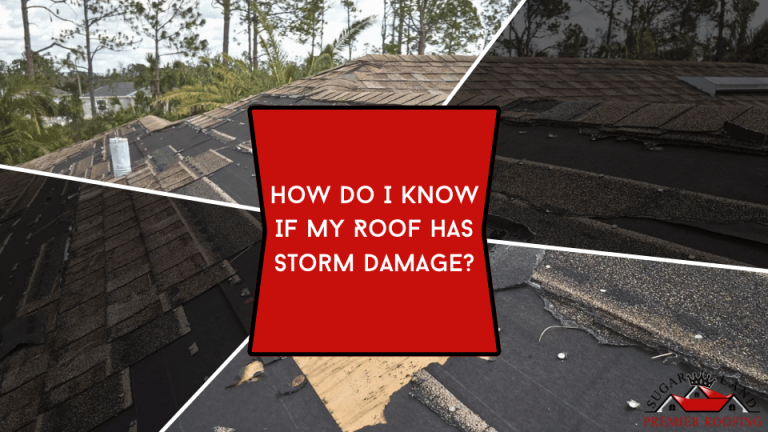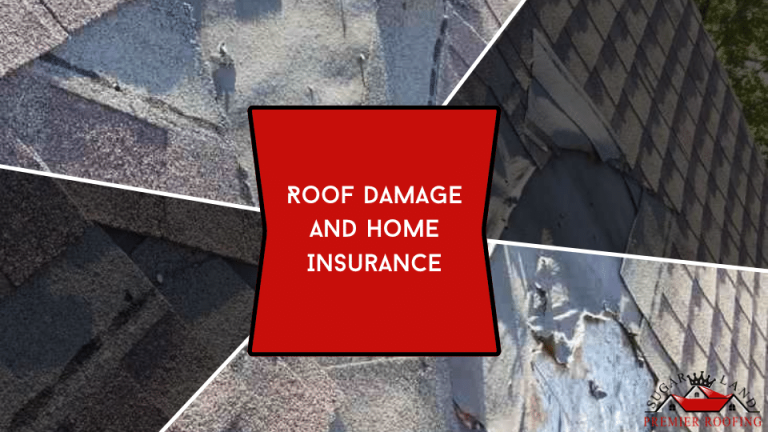As a homeowner in Sugar Land, Texas, you’re no stranger to unpredictable weather. From hail to high winds, storms in the area can bring significant damage to your roof—often without you even realizing it. Your roof is the first line of defense against the elements, so identifying storm damage early is crucial to protecting your home and avoiding costly repairs in the future. But now you’re asking yourself, “How do I know if my roof has storm damage? Sugar Land Premier Roofing is here to help you understand the signs and next steps.

1. Visible Roof Damage
After a storm, one of the first things you should do is take a walk around your home and inspect your roof from the ground. Look for the following signs:
- Missing or loose shingles: Strong winds can lift shingles off your roof, leaving areas exposed to further damage.
- Cracked or curled shingles: Hailstones and high winds can cause shingles to crack or curl, reducing their effectiveness in shielding your home from water.
- Granule loss: Shingles are coated with granules to protect them from UV rays and other elements. Check your gutters and downspouts for an excessive buildup of these granules. Bare patches on your shingles are a clear sign that they’re no longer protecting your roof adequately.
If you notice any of these visible signs, it’s best to contact a professional roofing company like Sugar Land Premier Roofing for a detailed inspection.
2. Leaky Ceilings or Water Spots
Storm damage isn’t always obvious from the outside. If water has penetrated your roof, you may start to see signs inside your home. Look out for:
- Water stains: Brown or yellowish rings on your ceiling or walls often indicate a roof leak.
- Peeling paint or wallpaper: Moisture trapped under your ceiling can cause the paint to bubble or peel.
- Mold or mildew: If water enters your attic or insulation, it can create a perfect environment for mold growth, which poses health risks for your family.
If you observe any of these signs, it’s essential to act quickly. Sugar Land Premier Roofing can perform an in-depth assessment and help you prevent further interior damage.
3. Hail Damage
Hailstorms can wreak havoc on your roof. While smaller hailstones may not cause significant damage, larger ones (over 1 inch in diameter) can create more obvious issues. Look for:
- Dents or bruises: Hail can leave dents in your shingles, which may not be immediately noticeable. These dents can cause the protective granules to dislodge and create weak spots in your roof.
- Cracks: In severe cases, hailstones can crack shingles, exposing the underlying materials to water.
If you suspect hail damage, it’s wise to get a professional inspection, as hail damage can shorten the life of your roof and lead to leaks down the road.
4. Damaged Flashing
Flashing is the material placed around chimneys, vents, and skylights to prevent water from seeping in. After a storm, check these areas to ensure they are still intact. Damaged or loose flashing can create entry points for water, leading to leaks and significant damage to your home’s structure over time.
5. Clogged or Damaged Gutters
Your gutters are crucial for diverting water away from your roof and home. However, after a storm, they can become clogged with debris such as leaves, branches, or even shingle granules. In some cases, strong winds or falling limbs can damage your gutters themselves. Make sure your gutters are clear and functioning properly after any major storm.
6. Fallen Debris
Large branches or debris falling onto your roof can cause direct physical damage. If you notice tree limbs on your roof after a storm, be cautious—there may be underlying issues you can’t see. Even if the roof appears undamaged, the impact can cause cracks or other structural weaknesses.
What Should You Do If You Suspect Storm Damage?
If you suspect that your roof has been damaged by a storm, it’s important to take immediate action. Here’s a step-by-step guide on what to do:
- Document the damage: Take photos of any visible damage. This will be helpful if you need to file an insurance claim.
- Schedule a professional inspection: Contact Sugar Land Premier Roofing for a comprehensive roof inspection. Our experienced team will assess the extent of the damage and provide you with a detailed report and recommendations.
- Contact your insurance company: If the damage is severe, you may need to file an insurance claim. Our team at Sugar Land Premier Roofing can help guide you through the process and ensure you get the coverage you deserve.
- Consider preventative maintenance: Even if the damage isn’t extensive, minor repairs now can save you from more significant issues later. Routine inspections and maintenance will extend the life of your roof and keep your home protected.
Why Choose Sugar Land Premier Roofing?
At Sugar Land Premier Roofing, we’ve built a reputation for providing top-tier roofing services in Sugar Land and the greater Houston area for over a decade. Our team is licensed, insured, and committed to excellence, with over 200 five-star reviews backing our commitment to customer satisfaction.
We’re also manufacture certified, which means we meet the highest standards set by leading roofing manufacturers. Whether you need a roof repair, replacement, or just an inspection, we’re here to help you keep your home safe, secure, and in top condition.
If you’re concerned about storm damage to your roof, don’t wait—contact Sugar Land Premier Roofing today at 832-307-3818 for a free consultation. Our experienced team is here to ensure your roof stays in top shape, no matter what Mother Nature throws your way.



